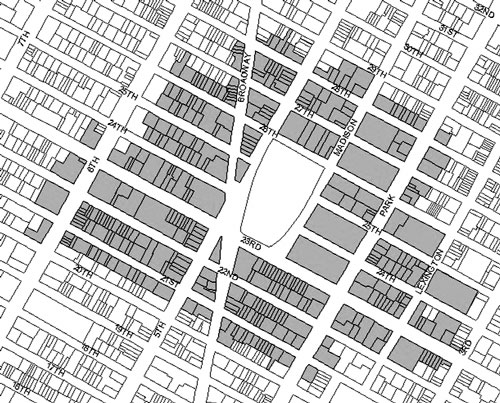By Albert Amateau
A map of the new business improvement district.
Mayor Mike Bloomberg last week signed his approval of the Flatiron 23rd St. Partnership, the city’s newest business improvement district, covering roughly 34 blocks between Lexington and Sixth Aves. from 21st to 28th Sts.
The Dec. 29 signing, in the presence of Sharon Ulman, president of the 23rd St. Association, which has been working with merchants, property owners and residents for the past four years on the BID formation, was the all-but-final step in the creation of the BID.
Formal requirements include a review within the next 45 days by the New York State comptroller, publication for two weeks in the City Record and a 30-day waiting period to allow any dissenting property owner to file objections before the BID begins providing augmented sanitation, security and business promotion services.
“We won’t be up and running until later in 2006,” said Ulman, who noted that the BID steering committee will organize a board of directors. That board will then search for and hire an executive director and issue requests for proposals for bidders who would provide the services.
The district, centered on 23rd St., includes the Flatiron Building at the intersection of Fifth Ave., Broadway and 23rd St., which gives the district its name. Madison Square Park, the toy and merchandise marts and New York Life and Metropolitan Life are also in the middle of the district, which encompasses 1,376 buildings totaling more 23,225 million square feet and 1,100 property owners.
The district is the home of 4,927 businesses of which 631 are ground-floor retail establishments and has 69,193 total employees, said Ulman.
While city and state law require BID’s, which operate under the supervision of the city Department of Small Business Services, to have the consent of 51 percent of the district property owners, Ulman said the Flatiron 23rd St. Partnership has nearly 100 percent support.
“We went to every property, every retail store, every residential building,” said Ulman. “We found only one residential condo owner who opposed the BID,” she said.
Commissioner Rob Walsh, who had been director of the14th St.-Union Square BID, the city’s first, before being tapped by Mayor Bloomberg to head the Department of Small Business Services, recalled that 23rd St. merchants and property owners were speaking about forming a BID 10 years ago.
“This is the first new BID in Manhattan in four years,” Walsh noted. “It’s an ideal area for a BID, with more than 600 retailers, but it does need some sprucing up,” he said after the mayoral signing last week.
BID’s are financed by an assessment on property in addition to city taxes. BID’s augment normal city services with private sanitation, additional security with unarmed but uniformed personnel and general marketing and business promotion intended to create a special commercial identity for the neighborhood.
Based on a projected annual budget of almost $1.7 million, the additional assessment for the Flatiron 23rd St. BID on commercial property is between 6 cents and 7 cents per square foot but residential buildings pay a token $1 a year.
Walsh agreed that Flatiron 23rd St. has one of the lowest BID assessments in the city. “They’ve done a great job with their budget and their next important step is to cast a wide net and find the best possible executive director,” he said.
The Bloomberg administration has supported BID’s throughout the five boroughs. At one point in the recent past, the Union Square Partnership, the BID to the south of the Flatiron District, proposed an expansion that would have made it contiguous with the present southern border of the Flatiron BID. But residential tenants opposed the expansion and the Union Square BID dropped the proposal.





































